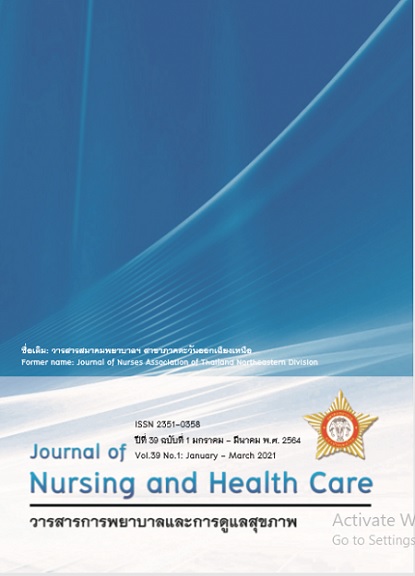The การพัฒนาแนวปฏิบัติการพยาบาลเพื่อป้องกันภาวะความดันในกะโหลกศีรษะสูง ในผู้ป่วยที่มีการระบายน้ำไขสันหลังจากโพรงสมอง โรงพยาบาลร้อยเอ็ด
คำสำคัญ:
clinical nursing practice guideline, Prevention complication, nursing management of Increased Intracranial Pressure, Traumatic Brain Injuryบทคัดย่อ
This research study aimed to develop a clinical nursing practice guideline for patients with Traumatic Brain Injury with external ventriculostomy for and to evaluate the guideline effectiveness regarding how it can be applied to patients by utilizing the evidence-based practice of a model devised by Soukup (2000) as a framework. The working steps consisted of analyzing and identifying problems, searching evidence, and assessing the creditability level and feasibility of implementation. The established clinical pathway was derived from the analysis of 10 research papers relating to prevention IICP patients. The developed clinical pathway was validated by 5 experts and adjusted for better application. The participants were included 14 Register nurse and 10 TBI patients. The results of this study were:
- The Important Develop technique on nursing intervention for prevention
complication from Increased Intracranial Pressure were included: 1) posture 2) assessment of vital signs and neurological symptoms 3) Look for warning signs of IICP 4) Respiratory care and 5) Care to promote cerebrospinal drainage. Establish a nursing practice guideline to prevent IICP and 3. For Nursing participated in nursing practice to prevent high intracranial pressure, cerebral injury patients with external ventricular drainage by monitoring and continuing care. The outcome of CNPG were guarantee patients safety with no incident of IICP and highly level of satisfaction score.
It is recommended that the developed CNPG: 1) should be implemented in actual situations in other surgery department and should be extended sample size and longitudinal period for traumatic brain injuries patients care
Downloads
เอกสารอ้างอิง
WHO; เข้าถึงออนไลน์ วันที่ 14 มกราคม 2564. https://www.who.int/publications/i/item/9789241565684
2. กองยุทธศาสตร์และแผนงาน สำนักงานปลัดกระทรวง กระทรวงสาธารณสุข. สรุปสถิติที่สำคัญ พ.ศ. 2562. ม.ป.ท.: 2562
กองยุทธศาสตร์และแผนงาน กระทรวงสาธารณสุข ตำบลตลาดขวัญ อำเภอเมือง จังหวัดนนทบุรี
3. สถาบันการแพทย์ฉุกเฉินแห่งชาติ. (2562). คู่มือแนวทางการบริหารจัดการระบบการแพทย์ฉุกเฉินระดับจังหวัด ฉบับที่ 1
พ.ศ. 2562. นนทบุรี: ปัญญมิตร การพิมพ์
4. ฉัตรกมล ประจวบลาภ. (2561). ภาวะความดันในกะโหลกศีรษะสูงในผู้ป่วยที่มีพยาธิสภาพที่สมอง: มิติของการพยาบาล
ตามหลักฐานเชิงประจักษ์. วารสารสภาการพยาบาล; 33(2) 15-28
5. Soukup SM. (2000). The Center for Advanced Nursing Practice evidence-based practice model:
Promoting the scholarship of practice. Nursing Clinics of North America; 35: 301-9.
6. The New Zealand guideline group. (2001). New Zealand guideline handbook (Online) Cited 2007 Aug);
Available from: www.nzgg.org.
7. Kemmis S and McTaggart R. (1987). The Action Research Planner. 3rd edition. Geelong: Australia:
Deakin University Press.
8. ฟองคำ ติลกสกุลชัย. (2553). การปฏิบัติการพยาบาลตามหลักฐานเชิงประจักษ์:หลักการและวิธีปฏิบัติ. กรุงเทพมหานคร
คณะพยาบาลศาสตร์มหาวิทยาลัยมหิดล
9. ราตรี สุขหงษ์. (2550). การป้องกันภาวะความดันในกะโหลกศีรษะสูงในผู้ป่วยบาดเจ็บสมองชนิดรุนแรง:การวิเคราะห์
ปัญหา. สารนิพนธ์ปริญญาพยาบาลศาสตรมหาบัณฑิต, บัณฑิตวิทยาลัย, มหาวิทยาลัยมหิดล
10. รุ่งนภา เขียวชะอ่ำ. (2559). ผลกระทบภายหลังการบาดเจ็บที่สมอง.วารสารวิทยาลัยพยาบาลพระปกเกล้า จันทบุรี ;
27:103-11
11. ระพี เสียงเสนาะ. (2552). การป้องกันภาวะความดันในกะโหลกศีรษะสูงในกลุ่มผู้ป่วยโรคทางระบบประสาทสมอง: การ
วิเคราะห์ปัญหา. สารนิพนธ์ปริญญาพยาบาลศาสตรมหาบัณฑิต
12. สมจิต จันทร์บาง, ศุภร วงศ์วทัญญู และสุภาพ อารีเอื้อ. (2556). ปัจจัยคัดสรรที่มีความสัมพันธ์กับการปฏิบัติการพยาบาล
เพื่อป้องกันภาวะความดันในกะโหลกศีรษะสูงในผู้ป่วยศัลยกรรมสมอง.รามาธิบดีพยาบาลสาร, 19(2), 264-275.
13. สุภา ตันติวิสุทธิ์, อำภาพร นามวงศ์พรหม และศศิธร ศิริกุล. (2555). ศึกษาประสิทธิผลของการพัฒนาระบบการพยาบาล
การใช้แนวปฏิบัติที่สร้างจากหลักฐานเชิงประจักษ์ต่อคุณภาพการดูแลผู้บาดเจ็บที่ศีรษะชนิดรุนแรง. วารสารสมาคม
พยาบาลฯ สาขาภาคตะวันออกเฉียงเหนือ; 29: 5-10
14. เสาวลักษณ์ ภูนวกุล, นพรัตน์ เรืองศรี, อรพรรณ มันตะรักษ์, และจารุภา คงรส. (2560). การพัฒนาแนวปฏิบัติการ
พยาบาลทางคลินิกสำหรับผู้ป่วยบาดเจ็บทางสมองที่ได้รับการผ่าตัดสมอง โรงพยาบาลพิจิตร.วารสารกรมการ
แพทย์; 42(6) 102-107
15. อุษา พงษ์เลาหพันธ์, ศุภร วงศ์วทัญญู, และกุสุมา คุววัฒนสัมฤทธิ์. (2552). กิจกรรมการพยาบาลและปัจจัยที่มีผลต่อการ
เกิดภาวะความดันในกะโหลกศีรษะสูงในผู้ป่วยบาดเจ็บที่ศีรษะ.รามาธิบดีพยาบาลสาร, 15(2), 221-232.
16. อุษา วงษ์อนันต์. (2558). การลดอุณหภูมิร่างกายผู้ป่วยสมองบาดเจ็บที่มีภาวะไข้. วารสารวิชาการสมาคม
สถาบันอุดมศึกษา เอกชนแห่งประเทศไทย;242(4):75-82.
17. Polit, D.F. and Beck, C.T. (2008) Nursing Research: Generating and Assessing Evidence for Nursing
Practice. 8th Edition, Wolters Kluwer Health/Lippincott Williams & Wilkins, Philadelphia.



